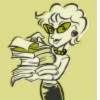 Beaumont, Karen. David Catrow (Ill.) 2004. I LIKE MYSELF. New York: Harcourt, Inc. ISBN 0-15-202013-6
Beaumont, Karen. David Catrow (Ill.) 2004. I LIKE MYSELF. New York: Harcourt, Inc. ISBN 0-15-202013-6More of a monologue than a story, I LIKE MYSELF is an upbeat piece about a little girl with a wonderful self-concept. Accompanied by her dog, she recites a litany of things she likes about herself. The protagonist also makes it clear she ascribes to the ‘sticks and stones’ mantra. “And I don’t care in any way what someone else may think or say.” By using words such as ‘cause and phrases like beaver breath, the reader can easily hear the childlike voice Beaumont has created. In addition, Beaumont’s use of rhyme and meter make this story fun to read aloud and read along. By using the cloze method in a read aloud, caregivers can encourage young children to finish sentences through the use of rhyme and context. For all the silliness within the text; the watercolor, ink and pencil illustrations are laugh-out-loud funny. Catrow’s ability to show emotion in facial expressions is evident in both the girl and her dog. Through the illustrations, we see the dog becoming more and more unnerved by the girl’s metamorphosis. However, even with a pig’s snout, horns, and purple polka-dotted lips, the faithful friend never leaves her side. Catrow’s hilarious illustrations keep readers engaged in the story, thus allowing the positive message of self confidence to be conveyed.
Highly recommended for readers ages 3-7 years. I can’t wait to read this one to Pre-K!





